 From one point of view, 1999’s The Phantom Menace was the ultimate “can’t-miss” proposition. 22 years after Star Wars erupted onto movie screens, the series remained enormously popular, and the 16 year wait for a fourth entry to finally emerge created an incredible appetite for a new entry. As such, Menace enjoyed a huge built-in audience that almost guaranteed its huge success.
From one point of view, 1999’s The Phantom Menace was the ultimate “can’t-miss” proposition. 22 years after Star Wars erupted onto movie screens, the series remained enormously popular, and the 16 year wait for a fourth entry to finally emerge created an incredible appetite for a new entry. As such, Menace enjoyed a huge built-in audience that almost guaranteed its huge success.
However, with that anticipation came severe expectations, and from a number of perspectives. Financially, Menace needed to earn an incredible amount of money to be considered a hit. Hollywood likes to pretend that $100 million is the benchmark for a success, but that figure has become woefully inadequate in recent years. During 2000, 22 movies attained that goal, while 21 made it in 1999. Through almost three-fourths of 2001, 13 flicks have grossed at least $100 million already; that tally will surely escalate substantially.
The situation seemed particularly harsh for Menace because of the pre-sold audience. Happily for its crew, not many really expected it to compete with the all-time best box office gross of 1997’s Titanic. A year earlier, some had touted Godzilla as a potential champion, but I think that flick’s relative failure financially - it ended up with $136 million and ninth place for 1998 - chastened many similar ideas about Menace. Nonetheless, expectations remained sky-high, and it seemed clear that the film needed to make a huge amount of money to be seen as a true hit.
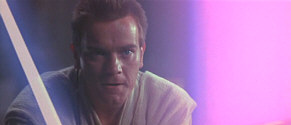 Personally, I felt that Menace had to take in at least $300 million in the US before it could be considered an actual success. To be sure, less money would have still left it profitable, especially when foreign markets and video sales are considered, but I thought that less than $300 million domestically would have be a relatively weak showing. Any figure lower than $200 million would have been a total disaster. Godzilla was seen as a flop with its $136 million; how bad would the carnage have been if Menace earned a similar figure?
Personally, I felt that Menace had to take in at least $300 million in the US before it could be considered an actual success. To be sure, less money would have still left it profitable, especially when foreign markets and video sales are considered, but I thought that less than $300 million domestically would have be a relatively weak showing. Any figure lower than $200 million would have been a total disaster. Godzilla was seen as a flop with its $136 million; how bad would the carnage have been if Menace earned a similar figure?
All of this became a moot point since Menace eventually grabbed $431 million domestically and passed the $900 million mark worldwide. That left it with almost exactly half of Titanic’s take, and it barely nudged out 1993’s Jurassic Park for the second spot on the worldwide chart; it was close, as Menace snagged $922 million compared to Jurassic’s $920 million. Even for me, this was enough to consider the film a genuine hit financially.
In other ways, however, Menace ran into trouble. Sure, hoards of people flocked to theaters, but how many of them actually liked the thing? Over the last few years, a myth has grown that states Titanic succeeded due to hype. That’s totally incorrect. Yes, we were inundated with Titanic media once the movie became it hit, but it made its money on its own. The pre-release publicity was pretty subdued for a major studio effort - especially one that cost so much to make - and expectations for it seemed rather low. Titanic became a success because a lot of people loved it. It went to another level partially due to curiosity - latecomers wanted to see what the fuss was about - but it had already proved itself by that point.
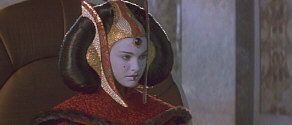 Menace, on the other hand, offered a completely presold phenomenon. Media attention was intense, as the film generated a level of advance interest virtually unseen. I remember some comments along the lines of “Menace is the most eagerly anticipated film since Godfather III” or some other flick. Technically this was correct, but the truth was that Menace was the most excitedly awaited movie ever. Never had so many looked forward to one film.
Menace, on the other hand, offered a completely presold phenomenon. Media attention was intense, as the film generated a level of advance interest virtually unseen. I remember some comments along the lines of “Menace is the most eagerly anticipated film since Godfather III” or some other flick. Technically this was correct, but the truth was that Menace was the most excitedly awaited movie ever. Never had so many looked forward to one film.
And I was among the fervent faithful. When Star Wars hit in 1977, I was 10, which placed me smack-dab in the middle of the movie’s main demographic: dorky young boys. Along with all my friends, we embraced Star Wars as the greatest thing ever, and I maintained that affection pretty much forever after that. Oh, I went through my geek-denial stage in the early Eighties when I tried to pretend I was too cool for silly sci-fi flicks. It didn’t take, as my inherent nerdiness rose to the surface.
Long ago I ceased to fight this attitude, and I embraced my affection for all things Star Wars with fervor. When Kenner created a new line of action figures in 1995, I leapt to purchase them, and I continue to collect them to this day. I purchased more reissues of the first three films on laserdisc than I care to remember; each allegedly offered something I needed to possess, so I did so gladly.
Frighteningly, by the time Menace hit screens in 1999, I’d waited literally half of my life to see it. I was 16 when its predecessor, 1983’s Return of the Jedi, appeared, and I was 32 when Menace emerged. That’s a looong time between movies, and though the public’s appetite for Star Wars diminished for a period in the early Nineties, by 1999 the series clearly had regained its prominence.
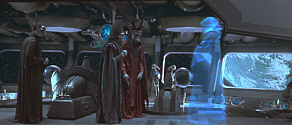 That occurred largely due to the reissue of the first three films in 1997. Packaged as updated “special editions”, those flicks performed shockingly well at the box office. The first two sequels in the saga - 1980’s The Empire Strikes Back and Jedi - did nicely for reissues, as they grabbed $67 million and $45 million respectively. However, the original Star Wars really brought home the bacon, as the SE nabbed an amazing $138 million. That meant it actually placed eighth in the year’s top-grossing film chart, an absolutely unprecedented accomplishment.
That occurred largely due to the reissue of the first three films in 1997. Packaged as updated “special editions”, those flicks performed shockingly well at the box office. The first two sequels in the saga - 1980’s The Empire Strikes Back and Jedi - did nicely for reissues, as they grabbed $67 million and $45 million respectively. However, the original Star Wars really brought home the bacon, as the SE nabbed an amazing $138 million. That meant it actually placed eighth in the year’s top-grossing film chart, an absolutely unprecedented accomplishment.
Would the mania for Menace have reached the same heights without the success of the SEs? Perhaps, but I doubt it. They made the Star Wars saga vital for an entirely new generation, and it became a hit with kids who otherwise might never have encountered it to such a degree. To be sure, any Star Wars sequel created in the late Nineties would have done spectacularly well, but I feel the SEs helped generate a new allegiance.
In any case, geeky aging fanboys like myself would have attended nonetheless, and I greeted the May 1999 release of Menace with fervor. I actually did my best to screen out any information about the film prior to my first screening, which was awfully tough. Still, I did well, and almost all of what I saw was new to me.
Really, all I knew about Menace before that showing came from some negative critical notices. Early reviews absolutely panned the film, so while I wasn’t aware of the specifics, I was informed that it inspired a lot of unfavorable opinions.
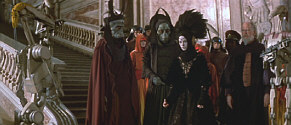 Those thoughts continued well after the movie’s release. Frankly, I have no idea what the general public consensus is, but among the fanboy faithful, the reaction wasn’t good. Personally, I felt Menace wasn’t a great film, but I thought it had enough going for it to keep my attention and entertain me, which was all I really expected of a Star Wars film.
Those thoughts continued well after the movie’s release. Frankly, I have no idea what the general public consensus is, but among the fanboy faithful, the reaction wasn’t good. Personally, I felt Menace wasn’t a great film, but I thought it had enough going for it to keep my attention and entertain me, which was all I really expected of a Star Wars film.
Also known as “Episode I”, Menace falls as the first segment in what will ultimately be a six-part saga; Star Wars, Empire and Jedi create the fourth, fifth and sixth installments of the series, respectively. Menace sets up the story of little Anakin Skywalker (Jake Lloyd), the boy who eventually becomes Darth Vader. We see his involvement in Jedi training by master Qui-Gon Jinn (Liam Neeson) and his wary pupil Obi-Wan Kenobi (Ewan McGregor). We also meet Amidala (Natalie Portman), the lovely young queen of a planet called Naboo, and that planet’s representative at the Galactic Council, Senator Palpatine (Ian McDiarmid).
The plot of Menace seems almost inconsequential, as it exists mainly to introduce all of these characters to us and to each other. Menace strongly echoes Star Wars itself, as some similar challenges and situations crop up along the way. It’s not a carbon copy of the first movie, but the connections clearly seem intentional.
One could argue that Menace was doomed to be a disappointment of sorts due to its inherent purpose. It stands as the most expositional of the six films. Star Wars really should take that honor, but because it was the only one that really was meant to stand on its own, it was made in a much more concise manner. Sure, Lucas may have desired to create a longer saga after Star Wars, but he didn’t know if this would be possible, so the first film exists as a stand-alone entity in ways the others don’t.
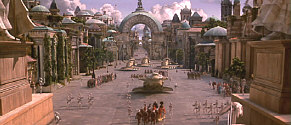 Although Menace relates to worlds and characters with whom we’re already familiar, there’s enough new to make this movie largely a piece of exposition. Due to that factor, it can be slow-paced and clumsy at times. Much of the second act - in which we meet Anakin - moves at a turgid rate, especially because this part of the flick offers the most background information. A fun podrace sequence enlivens this area, but it remains the movie’s biggest weakness.
Although Menace relates to worlds and characters with whom we’re already familiar, there’s enough new to make this movie largely a piece of exposition. Due to that factor, it can be slow-paced and clumsy at times. Much of the second act - in which we meet Anakin - moves at a turgid rate, especially because this part of the flick offers the most background information. A fun podrace sequence enlivens this area, but it remains the movie’s biggest weakness.
Otherwise, the first and third acts work pretty well. The opening period suffers somewhat from vagueness and a tentative quality, but it includes some solid action scenes and gets the ball rolling fairly effectively. As for the film’s conclusion, it also provides some scattered focus, especially during a four-pronged climax. However, that area includes the movie’s best work, which appeared during a fantastic lightsaber battle. I’ve seen Menace seven times now, but that part of the film never fails to give me goosebumps; even if the rest of the flick totally stunk, I’d still endorse it just for that sequence.
The remainder of Menace doesn’t bite, but it remains a bit flat and lackluster. I must admit that the film hasn’t endured repeated viewings especially well. I still enjoy it, but the flaws come through more clearly each time I watch it. I just can’t get into it to the degree that the first three involve me.
Ultimately that may be the greatest sin committed by The Phantom Menace: it’s not one of the first three films. In its own right, I think it’s a fairly entertaining and enjoyable film. The movie seems very erratic, but most of it works reasonably well. Is “reasonably well” good enough for a Star Wars film? Perhaps not, but I continue to find it to offer a fun and engaging experience for the most part.
 A few quick comments before I move on to the DVD itself: 1) I don’t mind Jar-Jar; 2) Jake Lloyd was atrocious as Anakin. While the former received the bulk of the film’s criticism, I thought the latter deserved more. Lloyd was the gaping hole at the heart of Menace, as his thick, ham-fisted performance was painful to watch at times. The boy couldn’t act, and he made the film falter consistently. Thank God he won’t appear in the next flick.
A few quick comments before I move on to the DVD itself: 1) I don’t mind Jar-Jar; 2) Jake Lloyd was atrocious as Anakin. While the former received the bulk of the film’s criticism, I thought the latter deserved more. Lloyd was the gaping hole at the heart of Menace, as his thick, ham-fisted performance was painful to watch at times. The boy couldn’t act, and he made the film falter consistently. Thank God he won’t appear in the next flick.
Hopefully Portman will have grown by then, for she wasn’t a great deal better than Lloyd. Actually, that’s too harsh, but Portman seemed very flat and listless. Perhaps this occurred because so many of her scenes came opposite Lloyd.
Of the remaining actors, both McGregor and Neeson were good but not special. I think Ewan will improve considerably during the next flick because he should have more to do; in Menace, he functioned as little more than Qui-Gon’s errand boy. When provoked in Menace - such as during the climax - McGregor came to life; here’s hoping he maintains that attitude during the next films.
The only actors I felt distinguished themselves in Menace were McDiarmid and Pernilla August. The latter played Anakin’s mother and she brought a wonderful depth and sense of pain to the role; she created an emotional core than her son lacked. As for McDiarmid, those familiar with his role know where he’ll end up eventually, and he did a great job of playing with that future. He embodied the slick politician and clearly had fun in the part.
 By the way, The Phantom Menace goes by a slew of different names. Some call it Star Wars: The Phantom Menace, some refer to it as Star Wars: Episode I, some say it’s Star Wars Episode I: The Phantom Menace, while some just name it Episode I. Why do I choose The Phantom Menace? Because that’s consistent with the common terminology for the first two sequels. No one refers to Star Wars: The Empire Strikes Back or Episode VI. They’re The Empire Strikes Back and Return of the Jedi, and that’s that.
By the way, The Phantom Menace goes by a slew of different names. Some call it Star Wars: The Phantom Menace, some refer to it as Star Wars: Episode I, some say it’s Star Wars Episode I: The Phantom Menace, while some just name it Episode I. Why do I choose The Phantom Menace? Because that’s consistent with the common terminology for the first two sequels. No one refers to Star Wars: The Empire Strikes Back or Episode VI. They’re The Empire Strikes Back and Return of the Jedi, and that’s that.
As for the first flick, it’s Star Wars, not A New Hope or Episode IV. Yes, I realize that this insistence on calling it Star Wars seems inconsistent alongside my other attitudes, but when it first came out, there was none of this A New Hope or Episode IV nonsense - it was just Star Wars, and I refuse to call it anything else.
The DVD:
The Phantom Menace appears in an aspect ratio of approximately 2.35:1 on this single-sided, dual-layered DVD; the image has been enhanced for 16X9 televisions. Just as the movie itself qualified as perhaps the most hotly anticipated flick ever, this release may encounter the greatest level of expectations yet seen in the world of DVD. Did it live up to those hopes? For the most part, I thought so, but one area offered a relative disappointment: picture quality. While much of Menace looked quite strong, the image suffered from enough minor problems to make it less than what I thought it would be.
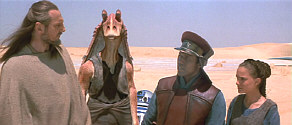 Overall, sharpness looked good, as most of the movie presented a crisp and detailed image. Some wider shots came across as mildly soft, but these occasions were rare. However, I did discern some slight examples of moiré effects and jagged edges at times, and edge enhancement provided some distinct concerns. A number of shots exhibited minor halos around objects and performers, and I believe the edge enhancement was what caused most of the apparent softness; the distortion rendered by the extra information made smaller items - like people in the distance - appear somewhat blurry. While the edge enhancement never reached the levels seen on DVDs like Die Hard With a Vengeance, it nonetheless led to an unnecessary degradation of visual quality.
Overall, sharpness looked good, as most of the movie presented a crisp and detailed image. Some wider shots came across as mildly soft, but these occasions were rare. However, I did discern some slight examples of moiré effects and jagged edges at times, and edge enhancement provided some distinct concerns. A number of shots exhibited minor halos around objects and performers, and I believe the edge enhancement was what caused most of the apparent softness; the distortion rendered by the extra information made smaller items - like people in the distance - appear somewhat blurry. While the edge enhancement never reached the levels seen on DVDs like Die Hard With a Vengeance, it nonetheless led to an unnecessary degradation of visual quality.
In regard to print flaws, they seemed non-existent for the most part. I saw no signs of speckles, grit, scratches, blotches, hairs or other surface defects. The only distractions came from some noticeable grain at times, but this stayed pretty minor throughout the film.
Colors usually appeared quite vivid and vibrant, as the movie offered a nicely varied and lively palette. From the mix of planetary settings to the costumes - especially those worn by Amidala - Menace really went for a solid spectrum of hues, and most of them seemed to be well replicated on the DVD. At times, however, I thought some of the colors looked a little heavy. Red lighting in the cockpit of the royal starship appeared mildly thick, and the golden sunlight that covered one scene on Coruscant also seemed too dense. As with my other concerns, these issues remained minor, but they occurred nonetheless.
Black levels looked very deep and rich throughout the movie. The film showed dark and solid tones at all times, and shadow detail usually appeared to be appropriately opaque but not excessively heavy. On a few occasions, low-light sequences looked moderately thick, but as a whole, that wasn’t a concern.
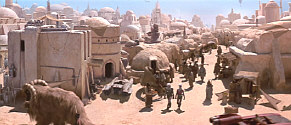 Overall, I did think that The Phantom Menace looked quite good. However, “good” just wasn’t good enough for a release such as this. Obviously I expect more from a big-budget modern film than I do from a cheap flick from 30 years ago, but Menace raised the bar even higher than usual. When expectations grow so intense, nothing but the absolute best will be greeted as such. Ultimately, I thought Menace presented a consistently positive image, but I must admit it disappointed me in the long run.
Overall, I did think that The Phantom Menace looked quite good. However, “good” just wasn’t good enough for a release such as this. Obviously I expect more from a big-budget modern film than I do from a cheap flick from 30 years ago, but Menace raised the bar even higher than usual. When expectations grow so intense, nothing but the absolute best will be greeted as such. Ultimately, I thought Menace presented a consistently positive image, but I must admit it disappointed me in the long run.
On the other hand, I will make no such complaints about the Dolby Digital EX 5.1 soundtrack of The Phantom Menace. I hate to award “A+” ratings for any aspect of a DVD. It’s not that I’m cruel or stingy; I just think that the highest possible accolades should be reserved for those situations in which the product really does provide virtually flawless material. I’ve written more than 1000 reviews, which means more than 3000 chances for me to give something an “A+” in regard to picture, sound or extras. How many times have I done this? Prior to this review, I’d only awarded 19 “A+”s.
Make that 21, as Menace qualified in two areas. I’ll discuss the terrific extras later, but now I need to cover the movies fantastic audio. As I watched the movie, I actively attempted to convince myself not to give the soundtrack an “A+”. Indeed, it wasn’t a perfect affair, as I noted a couple of minor concerns. For one, I thought John Williams’ score sounded slightly thin at times, and it occasionally lacked the punch I felt it deserved. The mix was also mastered at a surprisingly low level, which meant I needed to crank my speakers much higher than usual. I hate to do that, for I fear that a stray loud noise will pop out and destroy my system.
 However, those issues were small enough that they became erased by the soundtrack’s strong points. Make no mistake: this was an amazing piece of work, and it offered one of the smoothest and most enveloping soundfields I’ve ever heard. All five channels received an insanely active workout, as they were used for the vast majority of the film. Music remained mostly anchored to the front, where the score benefited from solid stereo separation and presence, but it also spread warmly to the surrounds. Some speech emanated from side and rear speakers at times as well.
However, those issues were small enough that they became erased by the soundtrack’s strong points. Make no mistake: this was an amazing piece of work, and it offered one of the smoothest and most enveloping soundfields I’ve ever heard. All five channels received an insanely active workout, as they were used for the vast majority of the film. Music remained mostly anchored to the front, where the score benefited from solid stereo separation and presence, but it also spread warmly to the surrounds. Some speech emanated from side and rear speakers at times as well.
Ultimately, though, the effects were the stars of the show, and they made this an incredible experience. Throughout the film, elements both loud and soft appeared from all around, and the mix melded together in a tremendously clean and believable manner. A great deal of unique audio cropped up in each speaker, and these pieces moved smoothly from channel to channel, with a presence that seemed to be virtually seamless. Nothing ever felt forced or awkward as it transitioned; instead, the elements cruised past us neatly. It was a wonderfully well-integrated soundfield that added to the film’s overall impact.
Audio quality also seemed to be excellent. Some dialogue showed its looped roots - a few lines didn’t fit the action well - but as a whole I thought the speech appeared natural and warm, and I heard no problems related to intelligibility or edginess. As I already noted, I felt the music occasionally sounded slightly thin, but overall the score was bright and dynamic, and it exhibited good dynamic range.
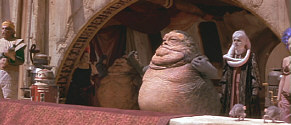 And then there are the effects. Across the board, these elements seemed to be extremely bold and aggressive, but they maintained excellent fidelity and showed no signs of distortion or harshness. A great deal of effort went into creating most of the stems, as much of the film used sounds that don’t exist in real life. They always appeared to be clear and realistic, and they sounded quite strong. Bass response was consistently deep and rich as well as loud, but the low-end stayed tight and warm.
And then there are the effects. Across the board, these elements seemed to be extremely bold and aggressive, but they maintained excellent fidelity and showed no signs of distortion or harshness. A great deal of effort went into creating most of the stems, as much of the film used sounds that don’t exist in real life. They always appeared to be clear and realistic, and they sounded quite strong. Bass response was consistently deep and rich as well as loud, but the low-end stayed tight and warm.
Best of the bunch? The podrace scene and the film’s climax. The latter stands as a test for your system’s bass response; the podracer engines really blast the low-end, and they provide a stiff challenge. If your system can handle it, though, you’ll encounter the most solid part of the movie, as all of the soundtrack’s strengths emerged during this sequence.
The climax also worked well because of the variety of elements. It encompassed a number of situations, and each had its own challenges. The lightsaber battle seemed most compelling, if just because of the bass impact displayed by their hum and crash. Note that though these were the most compelling parts of the mix, they didn’t stand in isolation. The Phantom Menace boasted an extremely solid soundtrack from start to finish.
One comment about subtitles: although the DVD lacks overall text for any language other than English, Spanish translations for some alien languages can be accessed. This option doesn’t appear in the main menu; you have to get to it manually. At least this will allow Spanish speakers to understand what Anakin, Watto and Sebulba say to each other in Huttese.
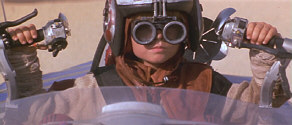 As one might infer from my comments, this meant that the DVD did not feature the original “burned-in” subtitles seen theatrically. This technique irritates many folks, and I can understand their concerns; player-generated text such as this often doesn’t blend very well with the action and it becomes a distraction. Such was the case with Menace. I thought the non-original subtitles looked “off” and they didn’t fit the film neatly. There wasn’t a lot of translated text, so this wasn’t the end of the world, but I would have definitely preferred to see the original subtitles.
As one might infer from my comments, this meant that the DVD did not feature the original “burned-in” subtitles seen theatrically. This technique irritates many folks, and I can understand their concerns; player-generated text such as this often doesn’t blend very well with the action and it becomes a distraction. Such was the case with Menace. I thought the non-original subtitles looked “off” and they didn’t fit the film neatly. There wasn’t a lot of translated text, so this wasn’t the end of the world, but I would have definitely preferred to see the original subtitles.
Another aspect of the high expectations that dogged the DVD release of The Phantom Menace related to its extras. Eager for Star Wars films on DVD, some have indicated that they’d be perfectly happy with “movie-only” editions, but the truth is that the uproar over such packages would be enormous. For these flicks, they must offer a deep package to succeed.
Happily, the supplements on Menace did the trick. Most of these appeared on DVD Two, but the first platter included a few bits, starting with an audio commentary. This track featured director/writer George Lucas, producer Rick McCallum, senior visual effects supervisor Dennis Muren, editor/sound designer Ben Burtt, animation director Rob Coleman, and visual effects supervisors John Knoll and Scott Squires. Although the commentary remained fairly screen-specific, most of the participants appear to have been recorded separately; Knoll, Squires and Coleman seemed to be together, but these rest sounded solo.
 That was fine with me, as I thought the format allowed for a fair amount of spontaneity but it came across as a tight, well-edited piece. As a whole, the commentary offered a lot of very solid information. Due to the qualifications of most of the participants, technical realms dominated the proceedings, but not to the degree one might anticipate. The discussion moved briskly across effects issues and overall story points, and Lucas was a very active speaker. He talked about a mix of issues that concerned him, such as fitting this story into the six-part whole and his editorial challenges. McCallum also contributed a lot of information about those topics.
That was fine with me, as I thought the format allowed for a fair amount of spontaneity but it came across as a tight, well-edited piece. As a whole, the commentary offered a lot of very solid information. Due to the qualifications of most of the participants, technical realms dominated the proceedings, but not to the degree one might anticipate. The discussion moved briskly across effects issues and overall story points, and Lucas was a very active speaker. He talked about a mix of issues that concerned him, such as fitting this story into the six-part whole and his editorial challenges. McCallum also contributed a lot of information about those topics.
The others provided a slew of fun facts about the technical side, and Burtt emerged as perhaps the most compelling speaker. As was the case during the Cast Away commentary - on which Randy Thom richly discussed his work - I loved this opportunity to learn more about sound design, and Burtt added some great material to the table. Overall, the commentary for Menace wasn’t a classic, but it offered a consistently entertaining and informative listen that I really enjoyed.
Although there was no text version of the commentary, the track offered subtitles to identify the onscreen speakers. This was a terrific touch, as all of those nerdy white dudes start to sound alike after a while. It worked better than spoken introductions, because it didn’t interfere with the flow of the program, and the text popped up whenever the speaker changed.
 One unadvertised extra on DVD One related to the movie itself. For the DVD, Lucas reinserted some shots left out of the release version. These included some additional introductions prior to the pod race, a little footage during the competition, and an “air taxi” ride when our heroes made it to Coruscant. Overall, the material added about three minutes to the film, and the work was integrated cleanly into the overall package; if you aren’t familiar with the movie, you will find no signs to indicate the new additions. These segments can also be viewed in even longer renditions in the “Deleted Scenes” area on DVD Two.
One unadvertised extra on DVD One related to the movie itself. For the DVD, Lucas reinserted some shots left out of the release version. These included some additional introductions prior to the pod race, a little footage during the competition, and an “air taxi” ride when our heroes made it to Coruscant. Overall, the material added about three minutes to the film, and the work was integrated cleanly into the overall package; if you aren’t familiar with the movie, you will find no signs to indicate the new additions. These segments can also be viewed in even longer renditions in the “Deleted Scenes” area on DVD Two.
While it was fun to see these snippets back in the movie, I must admit I’d prefer that they either remained in the “Deleted Scenes” section or at least could be skipped via seamless branching. Fox recently used the latter technique to add a smidgen of footage during Die Hard, and it should have appeared here as well. It doesn’t harm the film to include this material; actually, I rather enjoyed the podrace stuff. However, the use of seamless branching makes everyone happy, since a lot of people prefer to be able to see the original film without alterations.
Also on DVD One was the THX Optimizer program. This seems very similar to the THX Optimode found on other DVDs like Close Encounters of the Third Kind and Tora! Tora! Tora!. It purports to help you set up your home theater to best present the movie on the disc in question. Apparently the Optimizer is unique for each DVD on which it’s included; unlike programs such as Video Essentials, the Optimizer should tweak your set-up differently every time. Frankly, I’ve been very happy with my already-established calibration and I’m afraid to muck with it, so I’ve never tried the Optimizer or the Optimode. If you lack calibration from Video Essentials or a similar program, or if you’re just more adventurous than I, the Optimizer could be a helpful addition.
 Some Easter Eggs appeared on DVD One. You can choose to vary the main menu screen and select any of the three choices - Naboo, Tatooine, and Coruscant - via selections made during the “Attention” screen when the DVD starts. For Naboo, hit “Audio” on your remote, while you should punch “2” for Tatooine. Coruscant is more complicated; enter “10+”, “2” and “2” for it. Or just let them come up randomly and save some battery power.
Some Easter Eggs appeared on DVD One. You can choose to vary the main menu screen and select any of the three choices - Naboo, Tatooine, and Coruscant - via selections made during the “Attention” screen when the DVD starts. For Naboo, hit “Audio” on your remote, while you should punch “2” for Tatooine. Coruscant is more complicated; enter “10+”, “2” and “2” for it. Or just let them come up randomly and save some battery power.
More interesting is DVD One’s other egg, a cute little gag reel. This brief piece includes DVD production credits and some goofs on the set, most of which involved a malfunctioning R2-D2. To get this, go to the “Options” screen and hit “10+” and “1” to make “11”, then punch “3” and “8” and you’ll go to this feature. Alternately, you can go straight to title 3 while you watch the movie. One nice touch: the folks at Lucasfilm actually finished the effects for these shots, as you can see in one that featured Jar-Jar; actor Ahmed Best has been removed and replaced by the computer-generated character.
Finally, DVD One finishes with some DVD-ROM-based Weblinks. You’ll find connections to the official Star Wars site as well as one to a place with content exclusive for owners of the DVD-ROM. At least that’s what the disc promises; as I write this three weeks prior to the DVD’s release, the site goes to nothing. I’m sure it’ll become active once the disc actually hits shelves, however.
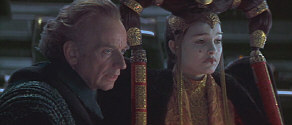 As we move to DVD Two, we find the bulk of the supplements. These were divided into different areas, and we’ll start with “Deleted Scenes and Documentaries”. Probably best of the bunch was an excellent documentary called The Beginning. When you tout your program as being culled from more than 600 hours of footage, you’d better deliver the goods, and this one does so in spades. Directed and filmed by John Shenk, this 66-minute and 15-second program offered a genuinely fascinating look at the production of Menace. Note that the piece didn’t attempt to be a traditional “making of” show in which we find a narrator and a neatly organized package. Instead, “The Beginning” took a looser path, but it remained absolutely compelling.
As we move to DVD Two, we find the bulk of the supplements. These were divided into different areas, and we’ll start with “Deleted Scenes and Documentaries”. Probably best of the bunch was an excellent documentary called The Beginning. When you tout your program as being culled from more than 600 hours of footage, you’d better deliver the goods, and this one does so in spades. Directed and filmed by John Shenk, this 66-minute and 15-second program offered a genuinely fascinating look at the production of Menace. Note that the piece didn’t attempt to be a traditional “making of” show in which we find a narrator and a neatly organized package. Instead, “The Beginning” took a looser path, but it remained absolutely compelling.
No real interviews took place, but we heard the thoughts of a slew of participants. Of course, Lucas dominated the piece, but we also saw shots of producer McCallum and a slew of additional crew. They may make some comments about their work as we watch them, but there were no attempts to question them strongly.
All of this may make it sound like “The Beginning” was a mess, but the truth was totally opposite. Instead, it moved at an appropriate pace and let the participants’ actions tell the story. It offered a wonderful “fly on the wall” tone that made it enthralling. I won’t list all of the great moments, for there were too many, but a few stood out, such as screen tests for Jake Lloyd and competitors - at least one of whom probably should have gotten the part - plus his frustrations when unable to pronounce “Coruscant”; instead of saying “Kor-oo-sant”, he’d call it “Kor-OOO-skant”.
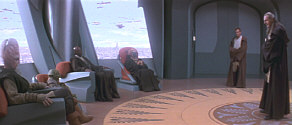 We also saw early rehearsal footage, Ewan McGregor’s haircut, the after-effects of a huge sandstorm, the first script reading, and a great deal more. I especially loved one moment when McCallum declared, “I think everybody’s in the right frame of mind” and the show then cut to a couple of extremely tired and demoralized looking crewmembers. Amazingly, “The Beginning” remained loose and candid but still seemed tight and concise. Shenk deserves much praise for this piece, as it’s one of the best documentaries I’ve seen. Its only fault stems from its length - it’s way too short! I could watch hours of this stuff.
We also saw early rehearsal footage, Ewan McGregor’s haircut, the after-effects of a huge sandstorm, the first script reading, and a great deal more. I especially loved one moment when McCallum declared, “I think everybody’s in the right frame of mind” and the show then cut to a couple of extremely tired and demoralized looking crewmembers. Amazingly, “The Beginning” remained loose and candid but still seemed tight and concise. Shenk deserves much praise for this piece, as it’s one of the best documentaries I’ve seen. Its only fault stems from its length - it’s way too short! I could watch hours of this stuff.
One odd aspect of the show stemmed from some language used. A few participants - most notably McCallum - say the “F”-word on occasion. The audio blocked part of the phrase; no “beeps” occurred but a little editing covered part of the term. Funnily enough, the program’s subtitles and closed-captioning totally alter the expression; they might read “ruined” instead of “f-ked”.
Next we found a presentation of seven Deleted Scenes. Not content to stay with the usual formula, this area also offered a “Deleted Scenes” documentary. On their own, the excised segments lasted between 56 seconds and six minutes, 59 seconds for a total of 17 minutes of material. All of these appear in their entirety during the documentary as well; it ran 37 minutes and 15 seconds including the deleted scenes.
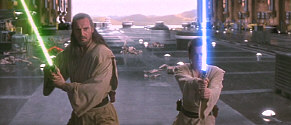 The documentary provided some solid information about the filmmaking process and the scenes themselves, and it was a very thorough and compelling piece. In addition to usual suspects Lucas, editors Ben Burtt and Paul Martin Smith and producer Rick McCallum, this program included remarks from filmmakers Francis Coppola and Philip Kaufman as well as editor Walter Murch. That group nicely detailed the choices that had to be made as part of the editing process, which was a good way to set up a discussion of the deletions themselves.
The documentary provided some solid information about the filmmaking process and the scenes themselves, and it was a very thorough and compelling piece. In addition to usual suspects Lucas, editors Ben Burtt and Paul Martin Smith and producer Rick McCallum, this program included remarks from filmmakers Francis Coppola and Philip Kaufman as well as editor Walter Murch. That group nicely detailed the choices that had to be made as part of the editing process, which was a good way to set up a discussion of the deletions themselves.
Once we got to that part of the documentary, we heard more specifics about the segments themselves, mainly in regard to the reasons they didn’t make the cut. These instances also included remarks from visual effects personnel Pablo Helman and Dean Yurke. The latter went into depth about the way in which he cleaned up the “Waterfall Sequence” for inclusion on the DVD.
That highlighted one terrific aspect of the presentation. Though none of these shots were fully finished for the final film, they were completed for inclusion on the DVD. This must have been fairly expensive, as they were all brought up to snuff; most look good enough to appear in the finished movie. Actually, a couple of them do; shorter versions of some podrace material and the air taxi make it to the DVD’s cut of Menace. Otherwise, a few of the effects still look a little dodgy, but I’m being very nitpicky, and I really appreciated the fact the visual elements were rendered to such a good degree of quality; they easily could have just been slapped on the disc in unfinished form and we’d still be happy. In addition, all of the scenes offered full Dolby Digital 5.1 sound, which was a very nice touch.
 As for the clips themselves, I found them to be very interesting. Did they deserve to make the finished film? Maybe. I did enjoy the extra podrace footage, and the rest of the snippets also seemed fun. Granted, this came from viewing them in isolation; since Menace tends to drag at times, it probably didn’t need an extra 17 minutes of footage. Still, I think one could argue for the inclusion of any and all of them, as they were generally worthwhile.
As for the clips themselves, I found them to be very interesting. Did they deserve to make the finished film? Maybe. I did enjoy the extra podrace footage, and the rest of the snippets also seemed fun. Granted, this came from viewing them in isolation; since Menace tends to drag at times, it probably didn’t need an extra 17 minutes of footage. Still, I think one could argue for the inclusion of any and all of them, as they were generally worthwhile.
One minor note about the documentary: some clips from other Star Wars films showed up during it. The scene from the first flick in which Han blasts Greedo appeared. Yup, it’s the SE version - Greedo shoots first!
That finished the “Deleted Scenes and Documentaries” area, so now we’ll move to “Featurettes, Web Documentaries, and Starwars.com”. In this domain we found a great deal of additional behind the scenes material. The Web Documentaries originally appeared on the official website, and we found 12 of them here. Each of these ran between three minutes, 33 seconds and seven minutes, 34 seconds for a total of 58 minutes and eight seconds of footage. Whew - that’s the equivalent of a full-length documentary!
These fit in nicely with the format used for “The Beginning”, as the 12 programs mainly used rough footage from the set. A wide variety of topics were covered, from Lucas’ very first day of writing the new script through production design, costumes, creatures, the casting of Anakin, problems with R2-D2 and other issues. The segments were long enough to provide acceptable detail; as a total Star Wars geek, I could always use more material, but I won’t complain that these were too short.
 All of the programs seemed to be compelling and entertaining, and they all felt appropriately candid. Of course, we’re not going to get any real dirt, but these segments lacked that “sanitized” tone that harms so many documentaries. Some of the material appeared elsewhere as well, but most of it seemed exclusive to these shows, and all of it was very informative and enjoyable. The segments about R2 and the Anakin cattle call were the most compelling, especially since the latter showed a little more of Lloyd’s competition; this made me even more convinced they picked the wrong kid.
All of the programs seemed to be compelling and entertaining, and they all felt appropriately candid. Of course, we’re not going to get any real dirt, but these segments lacked that “sanitized” tone that harms so many documentaries. Some of the material appeared elsewhere as well, but most of it seemed exclusive to these shows, and all of it was very informative and enjoyable. The segments about R2 and the Anakin cattle call were the most compelling, especially since the latter showed a little more of Lloyd’s competition; this made me even more convinced they picked the wrong kid.
Lastly, we got five Featurettes. Each of these lasted between seven minutes, 15 seconds and eight minutes, 37 seconds for a total of 40 minutes, 11 seconds of material. Geez, that means we found about two hours and 45 minutes of documentary material on the DVD - that ain’t too shabby!
Anyway, the “Featurettes” were the weakest link of the three documentary programs, but I still thought they were quite good in their own right. They covered five subjects: “Visual Effects”, “Costumes”, “Design”, “Fights” and “Story”. These used a format similar to the other programs, though the “Featurettes” came closest to traditional methods and relied more strongly on interview footage. These included comments from a variety of participants, and they showed the only real involvement of Liam Neeson, who seemed oddly absent from the other places.
Overall, the “Featurettes” added to and reinforced my understanding of the film’s creation. They provided a wealth of additional footage from the set as well as drawings and test material. Of the five, “Story” was the weakest, as it was the only one that felt like a promotional exercise; it had a couple of good moments, but mainly it just told us about the plot and the characters, which made it fairly useless. Best of the bunch was “Fights”, which showcased the wonderful climactic lightsaber battle. It displayed a great deal of good shots from rehearsals and the set, and I really liked it.
 The “Starwars.com” element just referred to the DVD-ROM links found on the disc. These replicated the same materials found on Disc One.
The “Starwars.com” element just referred to the DVD-ROM links found on the disc. These replicated the same materials found on Disc One.
Next we moved to the “Animatics and Still Galleries” domain. The Intro to Animatics provided a quick look at the process. The two-minute snippet told us about animatics and related why they’re used. From there we could look at animatics for Podrace Lap One and Submarine Sequence. Each of these offered four options: the original storyboards, the animatics and live action tests, the final shots from the film, and a screen that showed all three. The “Podrace” bit lasted two minutes, 38 seconds per element, while the “Submarine” bit ran 87 seconds per option. Personally, I most enjoyed the animatics/live action material, as these parts were very entertaining and illuminating.
The Exclusive Production Photos provided 76 stills from the set. These were all candid images with none of the usual bland promotional shots, and they all provided helpful captions. One nice touch stemmed from the viewer’s ability to zoom in on the photos and eliminate the captions if desired; this helped allow them to maximize the onscreen real estate.
One bizarre observation: we saw a still that showed the stunt double for Liam Neeson. In the picture shown, he bore an extremely strong resemblance to the “Qui-Gon Jinn Jedi Master” action figure. Did Hasbro base their sculpt on a photo of the wrong guy? It wouldn’t surprise me.
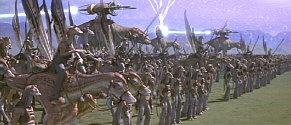 In the Print Campaign we found nine different permutations of the “One” ad series used for the film. Within each of those nine choices, you could flip through four variations on each theme. “Posters” added 17 ads, most of which were foreign translations of the same art. Again, we could skip through close-ups of the different posters, which was a nice touch.
In the Print Campaign we found nine different permutations of the “One” ad series used for the film. Within each of those nine choices, you could flip through four variations on each theme. “Posters” added 17 ads, most of which were foreign translations of the same art. Again, we could skip through close-ups of the different posters, which was a nice touch.
This area finished with one of the very few dull elements of this DVD: a featurette called “Star Wars Starfighter: the Making of a Game”. This four-minute piece told us some basics about the videogame in question, but it seemed to exist mainly to sell a few copies of that program. It added little to the package.
Finally, we went to the Trailers and TV Spots section of the DVD. There we found a 128-second “Teaser Trailer” and a 145-second “Theatrical Trailer”. I’d never actually seen these, as I purposefully avoided them in theaters; I wanted to know as little as possible about Menace before I saw it, so I refused to watch the ads. In addition, a music video for the “Duel of the Fates” theme appeared; it was pretty unspectacular, as it combined movie clips and behind the scenes shots for a lackluster presentation. Possibly most annoying was the fact that lots of dialogue and other intrusive auditory elements detracted from the music.
The “TV Spots” area added many other promos. We saw five “Tone Poems”, which were TV variations on the “One” theme seen in some advertising. One of these ran 60 seconds, while the other four lasted 30 seconds apiece, and they were a very interesting and unusual way to promote the film. More traditional were the other two ads, each of which ran for 30 seconds.
 Although I alluded to it earlier, I want to make one nice aspect of this package clear: almost all of the supplements provided both English subtitles and closed-captioning. The audio commentary had no text, and the “Starfighter” game featurette also lacked subtitles or CC. Otherwise, literally everything offered text for the hard of hearing - even the music video! This was a wonderful touch that made the set even more endearing. It really should be standard, however, and not an exception.
Although I alluded to it earlier, I want to make one nice aspect of this package clear: almost all of the supplements provided both English subtitles and closed-captioning. The audio commentary had no text, and the “Starfighter” game featurette also lacked subtitles or CC. Otherwise, literally everything offered text for the hard of hearing - even the music video! This was a wonderful touch that made the set even more endearing. It really should be standard, however, and not an exception.
Some additional Easter Eggs cropped up on DVD Two. Most notable were two behind the scenes video snippets that appeared in the “Deleted Scenes and Documentaries” area. If you go to the “Deleted Scenes Only” domain and highlight “Doc Menu” for both the “Complete Podrace Grid Sequence” and “Extended Podrace Lap Two”, you can then click to the right to discover these mini-featurettes. They lasted 157 seconds and 115 seconds, respectively, and they added some good information about those segments.
One other minor bonus: if you remain idle while in the “Animatics and Still Galleries” menu, Watto will float across the screen and demand that you choose something. This echoed a similar feature on the Terminator 2 Ultimate Edition, and it’s a fun little piece.
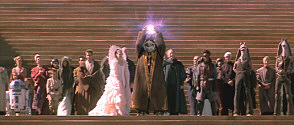 Although The Phantom Menace isn’t a great movie and it doesn’t compare with the first three films in the Star Wars saga, it offers enough fun and excitement to merit a look. Would I still like it as much if it didn’t reside in the Star Wars universe? Perhaps not, but that’s irrelevant at this point, and my moderate endorsement of the film stands.
Although The Phantom Menace isn’t a great movie and it doesn’t compare with the first three films in the Star Wars saga, it offers enough fun and excitement to merit a look. Would I still like it as much if it didn’t reside in the Star Wars universe? Perhaps not, but that’s irrelevant at this point, and my moderate endorsement of the film stands.
As for the DVD, it’s a less compromised affair. I found the good but not great picture quality to be a mild disappointment, but otherwise this was a top-rate disc. The soundtrack boasted an extremely aggressive and engrossing affair, while the extras in this two-disc set provided a virtual treasure trove of Star Wars information. I wish I could give the package a higher overall grade, but the picture flaws kept the DVD from total greatness. Nonetheless, The Phantom Menace is a fine disc that definitely earns your attention.